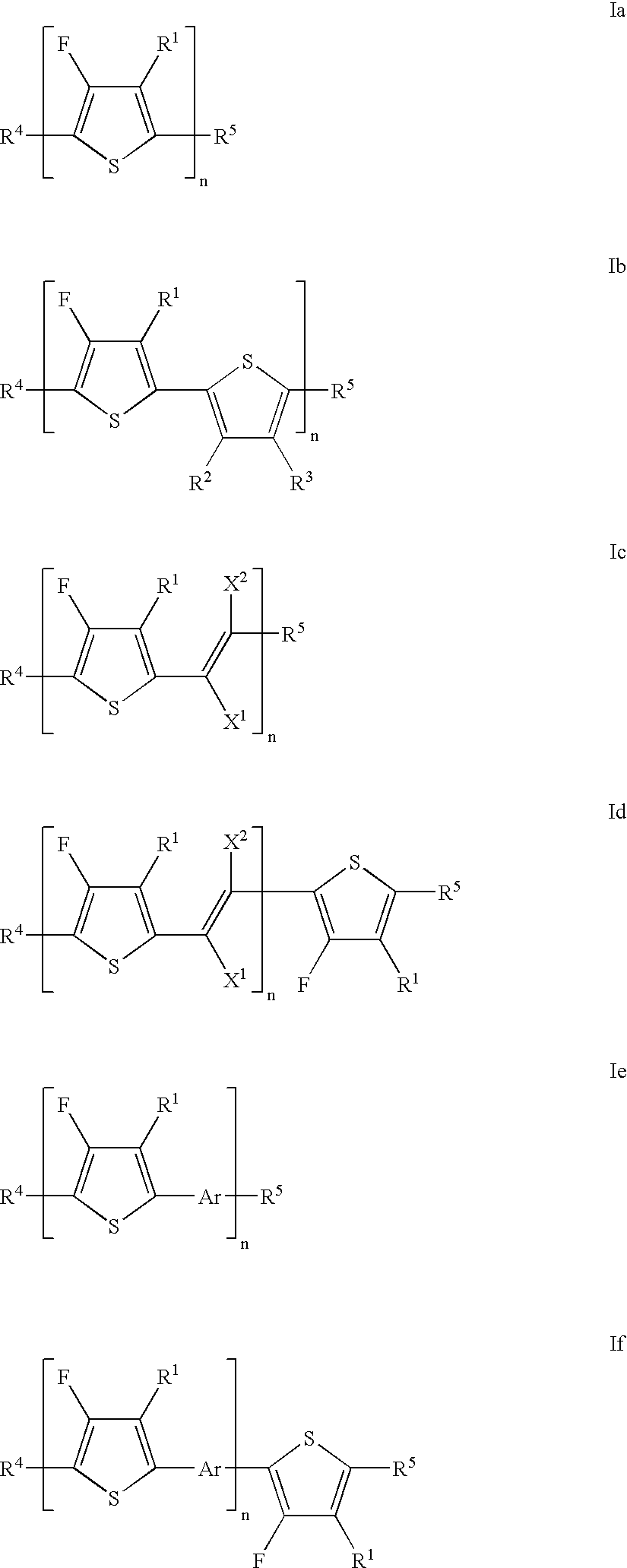Mono-, oligo- and poly-4-fluorothiophenes and their use as charge transport materials
a technology of poly(3-alkylthiophene) and charge transport material, which is applied in the direction of instruments, non-metal conductors, conductors, etc., can solve the problems of reduced device performance, low ionisation potential of poly(3-alkylthiophene)
- Summary
- Abstract
- Description
- Claims
- Application Information
AI Technical Summary
Benefits of technology
Problems solved by technology
Method used
Image
Examples
example 1
Preparation of Monomers
2,4,5-Tribromo-3-hexylthiophene (8):
3-Hexylthiophene (10 g, 60 mmol) was dissolved in dichloromethane (40 ml) and bromine (30.5 g, 191 mmol) in dichloromethane (10 ml) was added dropwise. Stirred for 7 h at RT and then refluxed for 4 h. Cooled and quenched with saturated potassium carbonate. The layers were separated and the aqeuous layer was further extracted with DCM (2.times.20 ml). The combined organics were washed with saturated sodium metabisulfite, water and brine, dried (Na.sub.2 SO.sub.4), filtered and concentrated under reduced pressure. The resulting yellow oil was filtered through a plug of silica (eluent: petrol 40-60) to afford 8 as a colourless oil (23.3 g, 95%). M.sup.+ =404 (t). .sup.1 H and .sup.13 C NMR spectra as expected.
2,5-(trimethylsilyl)-4-bromo-3-hexylthiophene (9):
2,4,5-Tribromo-3-hexylthiophene (8, 22.4 g, 55 mmol) was dissolved in anhydrous THF (250 ml) and cooled to -78.degree. C. n-BuLi (2.5M in hexanes, 120 mmol) was added dropw...
example 2
Preparation of Polymers
Poly(4-fluoro-3-hexylthiophene) (3):
2,5-Bromo-4-fluoro-3-hexylthiophene (7, 0.9 g, 2.62 mmol) was dissolved in anhydrous THF (20 ml) and methylmagnesium chloride (1M in butyl ether, 3 ml, 3 mmol) added dropwise at RT. The reaction was heated to reflux for 1 h and cooled to RT. A suspension of Ni(dimethylphosphinoethane)Cl.sub.2 (7.3 mg, 0.026 mmol) in THF (4 ml) was added via syringe and the reaction stirred at RT for 16 h. The reaction was heated for reflux for a further 6 h, cooled and poured into methanol. The resulting precipitate was filtered and washed with methanol and isohexane (via Soxhlet extraction). The precipitate was dissolved in a minimum volume of chloroform and re-precipitated from methanol (200 mL). The polymer was filtered off and dried under reduced pressure to afford poly(4-fluoro-3-hexylthiophene) as a dark red solid (3, 103 mg, 21%). .sup.1 H NMR as expected; typical molecular weights are around 10,000 with a polydispersity around 1.5.
PUM
| Property | Measurement | Unit |
|---|---|---|
| carrier mobilities | aaaaa | aaaaa |
| temperature | aaaaa | aaaaa |
| temperature | aaaaa | aaaaa |
Abstract
Description
Claims
Application Information
 Login to View More
Login to View More - Generate Ideas
- Intellectual Property
- Life Sciences
- Materials
- Tech Scout
- Unparalleled Data Quality
- Higher Quality Content
- 60% Fewer Hallucinations
Browse by: Latest US Patents, China's latest patents, Technical Efficacy Thesaurus, Application Domain, Technology Topic, Popular Technical Reports.
© 2025 PatSnap. All rights reserved.Legal|Privacy policy|Modern Slavery Act Transparency Statement|Sitemap|About US| Contact US: help@patsnap.com



